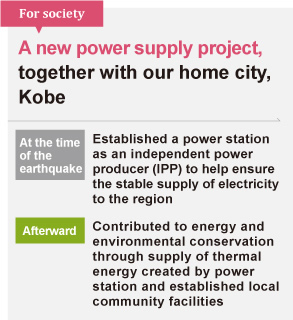Home > About Us > Sustainability Management > Sustainability Report > Sustainability Report 2015 > Special Feature: 20 Years after the Great Hanshin-Awaji Earthquake
 Special Feature:
Special Feature:
20 Years after the Great Hanshin-Awaji Earthquake
The bonds formed with stakeholders during the earthquake have helped to form the Kobe Steel Group of today.
Like many others, the Kobe Steel Group, which maintains its headquarters in the city of Kobe, suffered heavy damage from the Great Hanshin-Awaji Earthquake that struck on January 17, 1995. The earthquake reached a seismic intensity of 7 on the Japanese scale, damaging a blast furnace, buildings and production lines, as well as cutting off electricity and water supplies. Despite these conditions employees did their best to respond to the disaster, and their efforts to aid customers and the region helped to build long-lasting bonds of trust with our stakeholders.
Twenty years after the earthquake, we look back on those efforts and the lessons we have learned from the disaster.

For our customers
Maintaining production of the world's automobiles was a first priority.
![]()
In order to protect the parts supply chain, Kobe Steel outsourced production, sharing proprietary manufacturing knowledge with other steel companies.
The wire rod line, which supplied half of the world market, was heavily damaged.
![]()
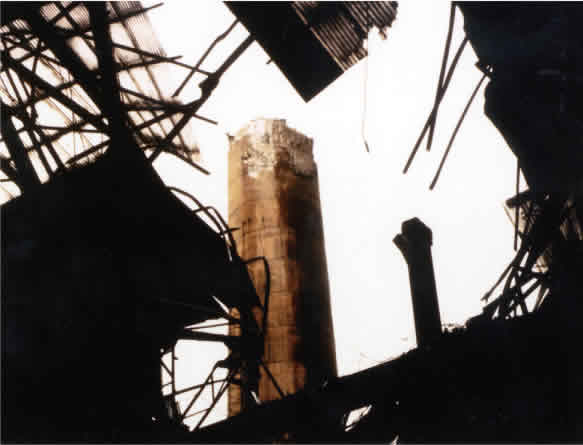
The Great Hanshin-Awaji Earthquake that occurred on January 17, 1995 caused heavy damage to key Kobe Steel facilities in Hyogo Prefecture. The Kobe Head Office was completely destroyed and the blast furnace at Kobe Works had to be shut down. Production equipment also sustained significant damage. This catastrophic situation threatened to bring worldwide production of automobiles to a halt.
Kobe Works is a major producer of wire rods and bars. In particular, the wire rods for automotive valve springs produced at the Works accounted for over half of the world market share. Damage to the wire rod line threatened to undermine the entire global automotive parts supply chain.
Proprietary manufacturing knowledge for wire rod production was shared with other steel companies.
![]()
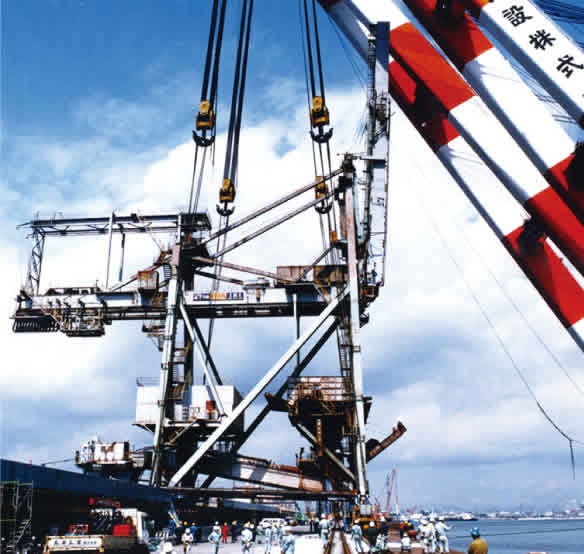
materials wharf
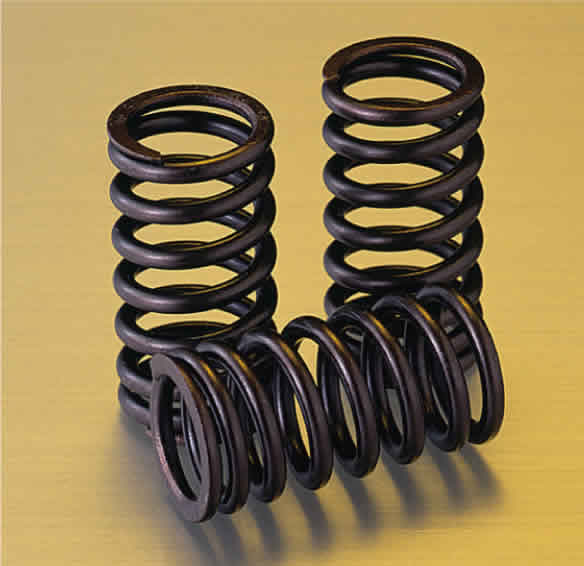
It was our obligation to our customers in the global automotive industry to ensure that the supply of wire rods for automotive valve springs continued uninterrupted. Until Kobe Works could recovery, we decided to outsource production and shared proprietary manufacturing knowledge with other steel companies.
Furthermore, the raw materials wharf at Kakogawa Works collapsed during the earthquake, damaging the Work's unloaders. We turned to other steelmakers for support, receiving unloaders to ensure the Works could go back into operation as quickly as possible.
Managers in the wire rod division at the time were prepared for the possibility that a portion of the outsourced production might not return to Kobe Steel afterward. However, a year after the earthquake, production of wire rods for automotive valve springs had returned to nearly the same level as before. Reflecting on this time, we can only extend our thanks once more to those companies that helped us when we were in need.
Meeting customer trust through development of large-scale earthquake business continuity plans.
![]()
Following the Great Hanshin-Awaji Earthquake, Kobe Steel began improving on the BCP (business continuity plan) it had previously put in place. The BCP lays out backup protocol to ensure that important operations remain uninterrupted in the event of a large-scale earthquake or in the case that interruption does occur, that operations can be resumed as quickly as possible. The plan's two major policies call for "ensuring employee life and safety" and "maintaining supply of products and services to customers."
For instance, in the case of an emergency, the plan calls for us to quickly establish a disaster response headquarters to support affected offices and plants. We have also installed satellite phones, emergency wireless communication systems and priority telephone lines at head offices, branches and plants, in case land lines and mobile phones become unavailable. Distributed real-time backup systems between plants and offices are also in place should host computers go down.
It has been 20 years since the Great Hanshin-Awaji Earthquake. The events of that day were tragic, but the lessons we learned have made us stronger, more ready to cope with disaster and more able to satisfy the trust placed in us by customers.
For the community
Kurogane Support Corps
![]()
Despite personal losses, the Kobe Steel Rugby Club rose to the occasion to help their community. Having learned from that disaster, they also assisted in the aftermath of the Great East Japan Earthquake.
The Kurogane Support Corps carried out local patrols, restoring peace of mind to disaster-affected areas.
![]()
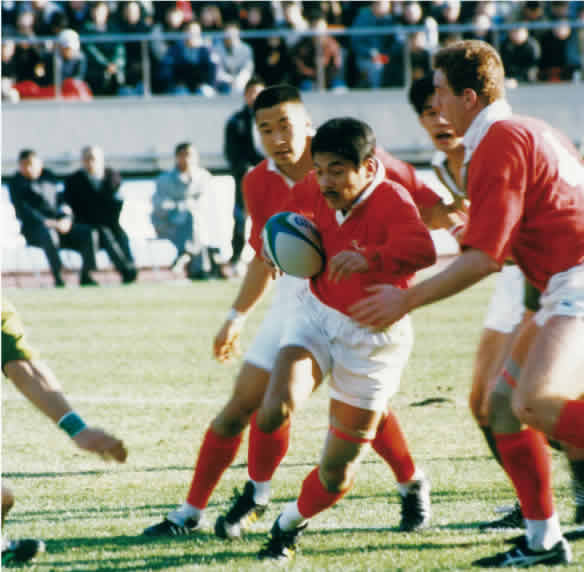
seventh consecutive all-Japan championship title in
1995
Approximately 38 hours after winning their seventh consecutive all-Japan title on January 15, 1995, the Kobe Steel Rugby Club was hit hard by the Great Hanshin-Awaji Earthquake. It was the first major earthquake members of the team had ever experienced. Despite their amazing victory just days before, the 48 members of the team—save a few who had remained behind in Tokyo—were caught in the very middle of the disaster. Many of the team members were forced into evacuation shelters after their homes in Kobe were destroyed.
Despite this setback, the club retained their team spirit: "One for all and all for one." Together with members of the company baseball and volleyball teams* they formed a neighborhood watch team, known as the Kurogane no Oentai (Kurogane Support Corps). Dressed in their orange jackets and helmets, they carried out 24-hour patrols of the areas where damage to homes and dormitories was highest. These patrols were a great comfort to local residents, who were combatting fear and uncertainty after the disaster.
*The baseball and volleyball teams have since been disbanded.
Shinko Hospital became a vital lifeline for the community.
![]()
During the Great Hanshin-Awaji Earthquake, Shinko Hospital* resembled a hospital in a war zone. In addition to treating the injured, the hospital also struggled with a host of problems, including maintaining electricity and food supplies and dealing with sanitation issues. Kobe Steel was quick to provide support to the hospital, which had become a lifeline for the area. We dispatched engineers to repair the hospital's emergency generators as quickly as possible and sent relief supplies that had been stored by the Group.
Two weeks after the earthquake the hospital expanded its efforts by sending volunteer physicians into disaster-struck areas. Additionally, after working on recovery efforts at Kobe Steel during the day, many employees volunteered at night to help with restoration efforts in the community.
*At the time of the earthquake Shinko Hospital was run by Kobe Steel. It became independent in 1998, as an incorporated medical institution of Shinko-Kai Association. It then became a social medical care corporation in April 2015.
Giving back to the Tohoku region.
![]()
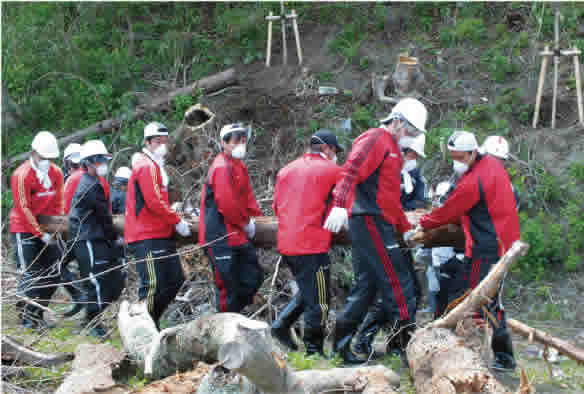
the Great East Japan Earthquake
Despite dealing with their own losses, Kobe Steel Group employees also strove to contribute to regional recovery efforts. During the next rugby season, as the Kobe Steel Rugby Club aimed for their eighth consecutive championship, they received significant support from the public at large. Unfortunately the team was unable to capture an eighth victory, but according to those involved at the time they took great inspiration from the public who came out to support them despite their own sufferings.
The team remembered this support when the Great East Japan Earthquake of 2011 occurred. They carried out disaster relief efforts in Kamaishi in June 2012 and held a "V7 Charity Match" in September of the same year. Former Kobelco Steelers from 20 years ago played against retired members of the Nippon Steel Kamaishi club. They also donated funds collected at matches and a portion of annual fan club membership fees toward recovery efforts. Having received so much support after the Great Hanshin-Awaji Earthquake-, the team wanted to give back to the similarly affected Tohoku region.
For our employees
Progress in safety and disaster prevention.
![]()
During the Hanshin-Awaji Earthquake, safety, disaster preparedness and good on-site judgment helped to keep approximately 400 people safe.
Since that time, we have continued to improve on our contingencies for large-scale earthquakes, accidents and other disasters.
A miracle at Kobe Works: 400 employees were safe.
![]()
There were approximately 400 employees at the Kobe Works when the level-7 earthquake hit at 5:46 am on January 17, 1995. Many were in the middle of dangerous work, including feeding molten iron into the No. 4 Converter, operating a forklift at the Bar Mill, and transporting hot metal. The lives of every employee at the Works were in danger. Looking back, it was a miracle that not a single worker suffered serious injury and all were safe.
While fate played a role, it was obviously more than good luck that contributed to people's safety that day. Safety and preventive measures to deal with accidents, earthquakes and other emergencies were already in place at Kobe Works and other Kobe Steel manufacturing sites. For instance, preparations were in place to deal with molten iron and other molten materials, and to ensure power during an emergency. Damage was minimized that day thanks to the knowledge and good judgment of our employees.
We were able to restart the blast furnace within 75 days, thanks to the dedication of our employees.
![]()
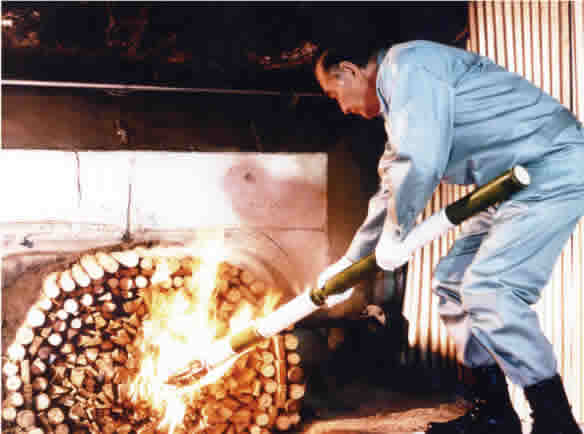
Blast Furnace at the Kobe Works
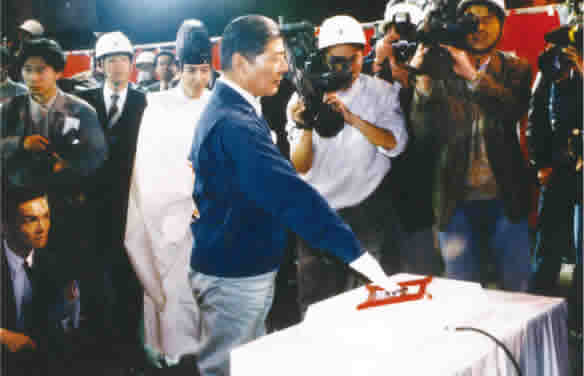
the button to restart hot blasts to the Kobe Works No.3
Blast Furnace
When the Hanshin-Awaji Earthquake occurred, the Kobe Works' No. 3 Blast Furnace went into emergency shutdown. The No. 2 Blast Furnace also suffered heavy damage. At the time, we expected it would take half a year before the furnaces could be restored to operation. We needed to restart the furnaces as soon as possible. Right after the earthquake we set up a Disaster Response Center to oversee swift recovery for the Kobe Works.
The skill of our employees contributed greatly to an early recovery for the blast furnaces. Although blueprints were lost during the earthquake, many of the employees were deeply familiar with the inner workings of the facility and were able to make accurate judgments. Thanks to the dedication of our employees, including engineers who were knowledgeable of the Work's cooling systems and other equipment, we were able to restore the blast furnaces to operation a mere 75 days after the earthquake occurred.
Coming together as a Group, in pursuit of greater safety and better disaster preparedness.
![]()
In the 20 years since the Great Hanshin-Awaji Earthquake, the Kobe Steel Group has continued to implement safety and disaster prevention measures to protect our employees' lives in the event of a large-scale earthquake or accident. Companywide earthquake countermeasure provisions are in place at Kobe Steel, and seismic checks and reinforcements are carried out on buildings where people are located. The standard for these buildings is that they should be able to resist functional damage (no collapse and repairable) even during an earthquake of seismic intensity 6 on the Japanese scale. We also identify workplace safety risks that could occur during an earthquake and implement appropriate countermeasures. For instance, measures are in place to stop coil from rolling during tremors. There are also emergency response guidelines in place to deal with the possibility of large-scale tsunami.
Additionally, we hold the Kobelco 1/17 Walk (Kobe Head Office) and drills to practice returning home after a disaster (at four locations including the Kobe and Tokyo head offices), to ensure that workers are familiar with commuting routes in the event that regular public transport becomes unavailable during an emergency. We also hold a group disaster prevention meeting each year and carry out surveys into disaster prevention at major Group offices and plants. The results of these surveys are used to improve disaster and personnel training. Through these and other measures we aim to continuously raise our level of safety and disaster prevention.
For society
A new power supply project, together with our home city of Kobe.
![]()
Kobe Steel's fate has and always will be closely tied to Kobe City. Understanding how important this connection is, we embarked on an IPP (independent power producer) project to cover approximately 70 percent of the power needs of the city.
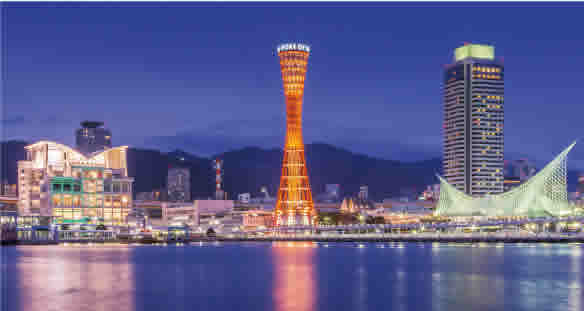
Kobe after recovery from the earthquake
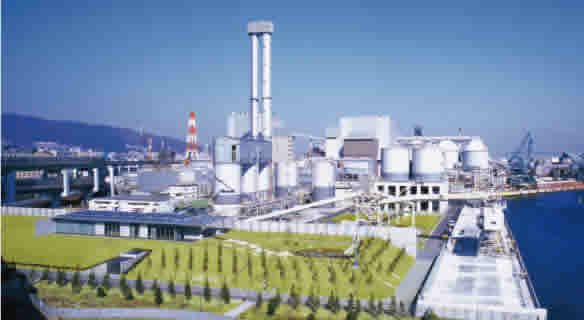
Shinko Kobe Power Station
The Kobe Steel Group's Wholesale Power Supply Business.
![]()
In the late 1990s, after the liberalization of the wholesale power supply industry, the Kobe Steel Group looked into creating a new IPP business based on a power station adjacent to the Kobe Works. However, building a power station in an urban setting demanded cautious consideration, and it was unclear at first whether we would be able to commercialize such an endeavor.
Protecting the power supply to Kobe City:
Earthquake provided new motivation for IPP Business.
![]()
The Great Hanshin-Awaji Earthquake caused severe damage to the region, and stable power supply became a significant long-term issue. As a result, in order to protect the city's infrastructure and contribute to a more stable supply of power in the region, Kobe Steel decided to move forward with its commercial IPP business.
The decision to move forward with a new IPP business during such a chaotic time showed Kobe Steel's dedication to the region. Then-president Sokichi Kametaka spoke to reporters about the decision. "Kobe Steel has no intention of moving away from Kobe. Our fates are linked, now and forever," he said. This sense of community and responsibility is what led us to start the new IPP business. In turn, we received significant encouragement and support from the people of Kobe, who had become keenly aware of the importance of electricity in light of the effects of the earthquake.
From power supply to community spaces, local contributions through IPP business continued to grow.
![]()
The Shinko Kobe Power Station was created to help ensure stable power supply to the region. The station's No. 1 Power Plant went into operation in 2002. The No. 2 Power Plant went into operation in 2004. Together, they are able to cover approximately 70 percent of Kobe City's power requirements during peak times. The station increases Kobe City's power self-sufficiency through a more diversified power supply network, thus helping to place the city on more stable ground in the event of a disaster.
As an important part of the community, the Kobe Shinko Power Station's role extends beyond simply power supply. Through the supply of thermal energy produced by the generators, the station also contributes to environmental and energy conservation in the region. A variety of community facilities has also been constructed adjacent to the power station, to provide members of the local community with places to gather, relax and refresh themselves. These include Nadahama Science Square, where children can experience the wonder and fascination of science and technology through play, the Nadahama Garden Baden health and spa facility, and Nadahama Sports Zone, which is open to the public and includes tennis courts and an artificial turf sports ground. Through our IPP business Kobe Steel connects with its hometown of Kobe in a variety of meaningful ways. We plan to continue contributing to the lives of people in the community well into the future.




